8 reasons why you should walk with a bushman
The Khomani San were a people who forgot their identity after they had been expelled from their ancient homelands to create the South Africa’s Gemsbok National Park in 1931. By the 1990s perhaps just fifty men and women remembered their proud heritage. For over 20,000 years the tribe had lived in the red sands and fitful scrub of the Kalahari.
 The tribe we nearly lost
The arrival of white settlers who classed the indigenous population as “vermin” made life increasingly difficult. As recently as 1927 the South African government issued a permit allowing a bushman to be hunted down. The hunters had become the hunted. After the fall of apartheid, a handful of Khomani San made a claim in the courts for compensation for the land they had lost.
The tribe we nearly lost
The arrival of white settlers who classed the indigenous population as “vermin” made life increasingly difficult. As recently as 1927 the South African government issued a permit allowing a bushman to be hunted down. The hunters had become the hunted. After the fall of apartheid, a handful of Khomani San made a claim in the courts for compensation for the land they had lost.
 They won the case. People who sensed they might be Khomani San traced their family roots, sometimes took DNA tests, and discovered their identity. If apartheid had arrived a generation later the Khomani San may have been lost forever.
A privilege
Walking through the Kalahari Desert, with a member of the Khomani is a rare but disturbing privilege. To step into the baking heat of the Kalahari is to cast off millennia of civilisation, to step out of your comfort zone, to step back to a time when human life was more precarious. As you walk through the soft red sand, interspersed with tufts of golden grasses, you suddenly feel vulnerable.
They won the case. People who sensed they might be Khomani San traced their family roots, sometimes took DNA tests, and discovered their identity. If apartheid had arrived a generation later the Khomani San may have been lost forever.
A privilege
Walking through the Kalahari Desert, with a member of the Khomani is a rare but disturbing privilege. To step into the baking heat of the Kalahari is to cast off millennia of civilisation, to step out of your comfort zone, to step back to a time when human life was more precarious. As you walk through the soft red sand, interspersed with tufts of golden grasses, you suddenly feel vulnerable.
 Your mobile phone lost reception many miles and hours ago. The only water you have is what your carry. If you were to be bitten by a puff adder, stung by a scorpion or mauled by a lion you are at least three-hours drive from the nearest hospital in Uppington. To walk with a bushman is to learn what it was to be human in a different era, a different world.
A simple life
As the bushman, from the Living Museum of the Khomani San, walks with just a loin-cloth, bow and arrows it is a lesson in how little mankind needs: ultimate minimalism. The bushman’s bow has been carefully whittled from a branch over a day or two, then strung with the tendon of a Gemsbok, testimony to both the bushman’s patience and his ingenuity.
Your mobile phone lost reception many miles and hours ago. The only water you have is what your carry. If you were to be bitten by a puff adder, stung by a scorpion or mauled by a lion you are at least three-hours drive from the nearest hospital in Uppington. To walk with a bushman is to learn what it was to be human in a different era, a different world.
A simple life
As the bushman, from the Living Museum of the Khomani San, walks with just a loin-cloth, bow and arrows it is a lesson in how little mankind needs: ultimate minimalism. The bushman’s bow has been carefully whittled from a branch over a day or two, then strung with the tendon of a Gemsbok, testimony to both the bushman’s patience and his ingenuity.
 Adapting and using every resource available men and women lived a simple life in this most unforgiving of environments. In the Southern Hemisphere summer day time temperatures can exceed 40 C but in winter, at night, they drop to -10 Centigrade. Yet the Khomani San thrived in this harsh environment for over 20,000 years.
What we have lost
As we, the visitors, take our walking safaris through this dangerous land there is a realisation that we have lost so much. Slapping on factor 50 sun-cream. Adjusting our glare-reflecting sun-glasses. Covering skin exposed to the sun. Tying laces on our boots to protect us from scorching sand.
Adapting and using every resource available men and women lived a simple life in this most unforgiving of environments. In the Southern Hemisphere summer day time temperatures can exceed 40 C but in winter, at night, they drop to -10 Centigrade. Yet the Khomani San thrived in this harsh environment for over 20,000 years.
What we have lost
As we, the visitors, take our walking safaris through this dangerous land there is a realisation that we have lost so much. Slapping on factor 50 sun-cream. Adjusting our glare-reflecting sun-glasses. Covering skin exposed to the sun. Tying laces on our boots to protect us from scorching sand.
 Suddenly we see that as First World intruders we have lost the ability of naturally adapting to any land, however challenging it may seem. As we trek and lose sight of the safari vehicle we grow silent, watchful and uneasy.
Inventive survival
Hundreds of miles south of Northern Cape Province, the people of Cape Town with their car washes, power showers and sprinkler systems worry about “Day Zero”: the day when the water runs out. As the bushman walks through a desert that may receive as little as six inches of rain in a year and where the two “dry rivers”, – the merest green tinge along the river beds hinting at the existence of rivers that run once or twice a century – it is a reminder of how man can be inventive.
Suddenly we see that as First World intruders we have lost the ability of naturally adapting to any land, however challenging it may seem. As we trek and lose sight of the safari vehicle we grow silent, watchful and uneasy.
Inventive survival
Hundreds of miles south of Northern Cape Province, the people of Cape Town with their car washes, power showers and sprinkler systems worry about “Day Zero”: the day when the water runs out. As the bushman walks through a desert that may receive as little as six inches of rain in a year and where the two “dry rivers”, – the merest green tinge along the river beds hinting at the existence of rivers that run once or twice a century – it is a reminder of how man can be inventive.
 When times are hard mankind can adapt. The bushman picks a sprig of bittersaw leaves for us to taste, his ancestors used this to assuage their thirst whilst hunting. Then he sees a gemsbok pawing at the ground, the Bushman continues the digging and reveals a prickly but succulent gemsbok cucumber, an excellent source of water.
UNESCO recognition
UNESCO have recognised that the unique ethnobotanical knowledge of the Khomani San should be preserved. Such is their intimate knowledge of the environment that the social weaver birds’ nest becomes their brewery: bird doppings were mixed with honey and water to create a brew so potent that only the tribal elders were allowed to drink it. Roots from the shepherd tree were dried and roasted to create the tribe’s coffee.
When times are hard mankind can adapt. The bushman picks a sprig of bittersaw leaves for us to taste, his ancestors used this to assuage their thirst whilst hunting. Then he sees a gemsbok pawing at the ground, the Bushman continues the digging and reveals a prickly but succulent gemsbok cucumber, an excellent source of water.
UNESCO recognition
UNESCO have recognised that the unique ethnobotanical knowledge of the Khomani San should be preserved. Such is their intimate knowledge of the environment that the social weaver birds’ nest becomes their brewery: bird doppings were mixed with honey and water to create a brew so potent that only the tribal elders were allowed to drink it. Roots from the shepherd tree were dried and roasted to create the tribe’s coffee.
 They would follow the desert xox as he sniffed for desert truffles, scaring him away to take the prize. To us the tribe’s lifestyle may seem basic but they enjoyed their luxuries.
A different sense of time
The Khomani San had a different concept of time that contrasts with our time-poor contemporary frantic lives. Once an animal had been wounded by their poisoned arrow they would track it for days until it fell, giving thanks for its life before cooking it.
They would follow the desert xox as he sniffed for desert truffles, scaring him away to take the prize. To us the tribe’s lifestyle may seem basic but they enjoyed their luxuries.
A different sense of time
The Khomani San had a different concept of time that contrasts with our time-poor contemporary frantic lives. Once an animal had been wounded by their poisoned arrow they would track it for days until it fell, giving thanks for its life before cooking it.
 They would chew on hoodia leaves to depress their hunger, they could not stop to eat whilst tracking. Seeing a bee they would follow it hoping to find its hive. If they lost it they would return to that spot until they picked up the trail again. Patience personified.
Arts and culture
As a sophisticated people the Khomani San had time for culture: they danced and they created jewellery. Watch men and women burn intricate designs into fragments of ostrich egg to create necklaces and bracelets at the Xaus Craft Village.
They would chew on hoodia leaves to depress their hunger, they could not stop to eat whilst tracking. Seeing a bee they would follow it hoping to find its hive. If they lost it they would return to that spot until they picked up the trail again. Patience personified.
Arts and culture
As a sophisticated people the Khomani San had time for culture: they danced and they created jewellery. Watch men and women burn intricate designs into fragments of ostrich egg to create necklaces and bracelets at the Xaus Craft Village.
 Spend a night with the Khomani San and you will see the traditional shuffling trance-dance of the men as they circle the fire. Take that walk with a bushman and you will be helping to preserve the rich heritage of the Khomani San.
Spend a night with the Khomani San and you will see the traditional shuffling trance-dance of the men as they circle the fire. Take that walk with a bushman and you will be helping to preserve the rich heritage of the Khomani San.
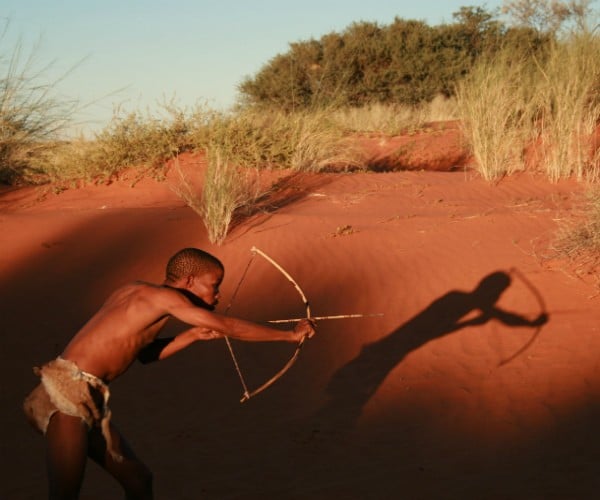 The tribe we nearly lost
The arrival of white settlers who classed the indigenous population as “vermin” made life increasingly difficult. As recently as 1927 the South African government issued a permit allowing a bushman to be hunted down. The hunters had become the hunted. After the fall of apartheid, a handful of Khomani San made a claim in the courts for compensation for the land they had lost.
The tribe we nearly lost
The arrival of white settlers who classed the indigenous population as “vermin” made life increasingly difficult. As recently as 1927 the South African government issued a permit allowing a bushman to be hunted down. The hunters had become the hunted. After the fall of apartheid, a handful of Khomani San made a claim in the courts for compensation for the land they had lost.
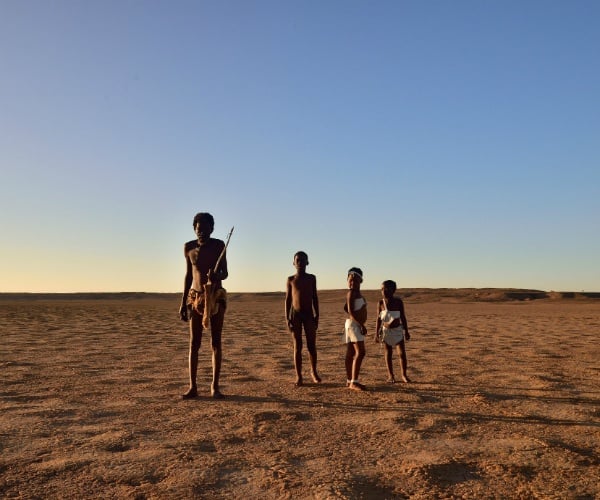 They won the case. People who sensed they might be Khomani San traced their family roots, sometimes took DNA tests, and discovered their identity. If apartheid had arrived a generation later the Khomani San may have been lost forever.
A privilege
Walking through the Kalahari Desert, with a member of the Khomani is a rare but disturbing privilege. To step into the baking heat of the Kalahari is to cast off millennia of civilisation, to step out of your comfort zone, to step back to a time when human life was more precarious. As you walk through the soft red sand, interspersed with tufts of golden grasses, you suddenly feel vulnerable.
They won the case. People who sensed they might be Khomani San traced their family roots, sometimes took DNA tests, and discovered their identity. If apartheid had arrived a generation later the Khomani San may have been lost forever.
A privilege
Walking through the Kalahari Desert, with a member of the Khomani is a rare but disturbing privilege. To step into the baking heat of the Kalahari is to cast off millennia of civilisation, to step out of your comfort zone, to step back to a time when human life was more precarious. As you walk through the soft red sand, interspersed with tufts of golden grasses, you suddenly feel vulnerable.
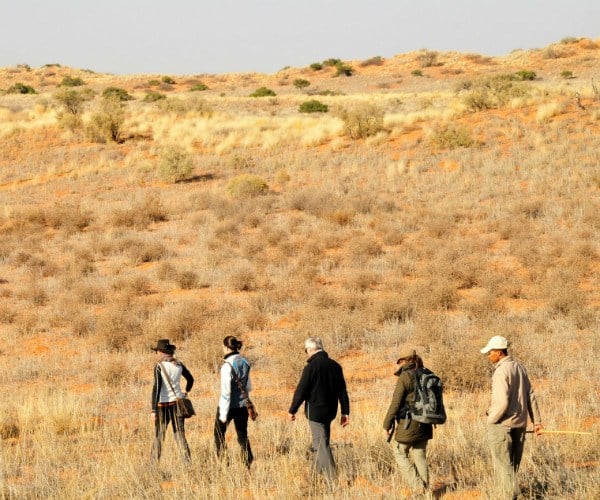 Your mobile phone lost reception many miles and hours ago. The only water you have is what your carry. If you were to be bitten by a puff adder, stung by a scorpion or mauled by a lion you are at least three-hours drive from the nearest hospital in Uppington. To walk with a bushman is to learn what it was to be human in a different era, a different world.
A simple life
As the bushman, from the Living Museum of the Khomani San, walks with just a loin-cloth, bow and arrows it is a lesson in how little mankind needs: ultimate minimalism. The bushman’s bow has been carefully whittled from a branch over a day or two, then strung with the tendon of a Gemsbok, testimony to both the bushman’s patience and his ingenuity.
Your mobile phone lost reception many miles and hours ago. The only water you have is what your carry. If you were to be bitten by a puff adder, stung by a scorpion or mauled by a lion you are at least three-hours drive from the nearest hospital in Uppington. To walk with a bushman is to learn what it was to be human in a different era, a different world.
A simple life
As the bushman, from the Living Museum of the Khomani San, walks with just a loin-cloth, bow and arrows it is a lesson in how little mankind needs: ultimate minimalism. The bushman’s bow has been carefully whittled from a branch over a day or two, then strung with the tendon of a Gemsbok, testimony to both the bushman’s patience and his ingenuity.
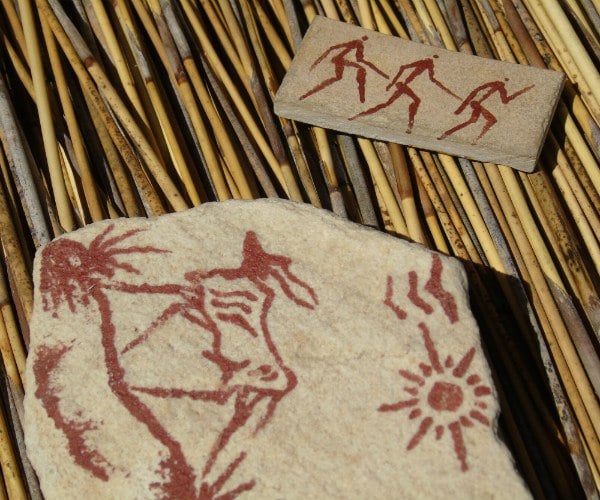 Adapting and using every resource available men and women lived a simple life in this most unforgiving of environments. In the Southern Hemisphere summer day time temperatures can exceed 40 C but in winter, at night, they drop to -10 Centigrade. Yet the Khomani San thrived in this harsh environment for over 20,000 years.
What we have lost
As we, the visitors, take our walking safaris through this dangerous land there is a realisation that we have lost so much. Slapping on factor 50 sun-cream. Adjusting our glare-reflecting sun-glasses. Covering skin exposed to the sun. Tying laces on our boots to protect us from scorching sand.
Adapting and using every resource available men and women lived a simple life in this most unforgiving of environments. In the Southern Hemisphere summer day time temperatures can exceed 40 C but in winter, at night, they drop to -10 Centigrade. Yet the Khomani San thrived in this harsh environment for over 20,000 years.
What we have lost
As we, the visitors, take our walking safaris through this dangerous land there is a realisation that we have lost so much. Slapping on factor 50 sun-cream. Adjusting our glare-reflecting sun-glasses. Covering skin exposed to the sun. Tying laces on our boots to protect us from scorching sand.
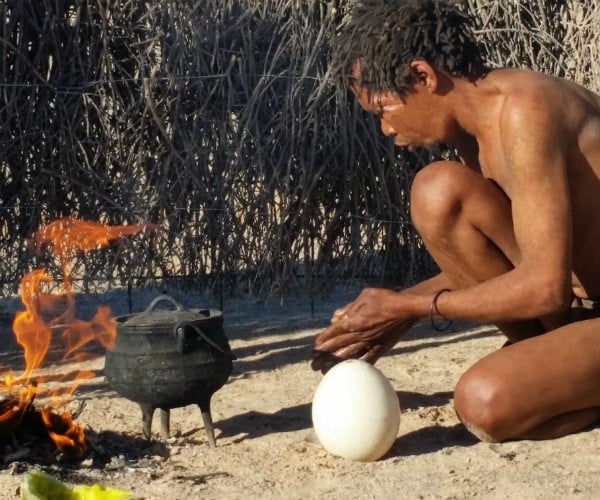 Suddenly we see that as First World intruders we have lost the ability of naturally adapting to any land, however challenging it may seem. As we trek and lose sight of the safari vehicle we grow silent, watchful and uneasy.
Inventive survival
Hundreds of miles south of Northern Cape Province, the people of Cape Town with their car washes, power showers and sprinkler systems worry about “Day Zero”: the day when the water runs out. As the bushman walks through a desert that may receive as little as six inches of rain in a year and where the two “dry rivers”, – the merest green tinge along the river beds hinting at the existence of rivers that run once or twice a century – it is a reminder of how man can be inventive.
Suddenly we see that as First World intruders we have lost the ability of naturally adapting to any land, however challenging it may seem. As we trek and lose sight of the safari vehicle we grow silent, watchful and uneasy.
Inventive survival
Hundreds of miles south of Northern Cape Province, the people of Cape Town with their car washes, power showers and sprinkler systems worry about “Day Zero”: the day when the water runs out. As the bushman walks through a desert that may receive as little as six inches of rain in a year and where the two “dry rivers”, – the merest green tinge along the river beds hinting at the existence of rivers that run once or twice a century – it is a reminder of how man can be inventive.
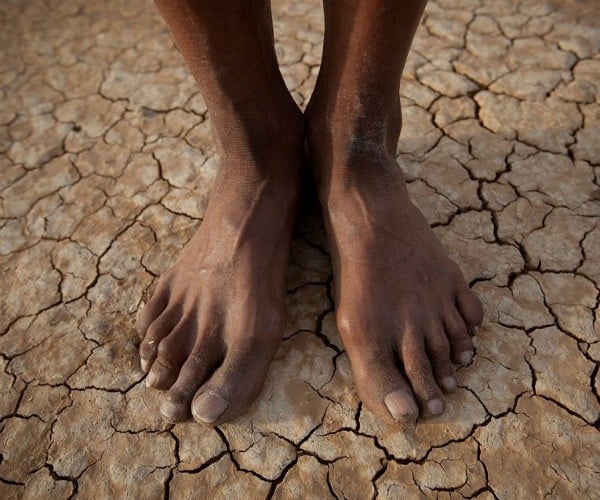 When times are hard mankind can adapt. The bushman picks a sprig of bittersaw leaves for us to taste, his ancestors used this to assuage their thirst whilst hunting. Then he sees a gemsbok pawing at the ground, the Bushman continues the digging and reveals a prickly but succulent gemsbok cucumber, an excellent source of water.
UNESCO recognition
UNESCO have recognised that the unique ethnobotanical knowledge of the Khomani San should be preserved. Such is their intimate knowledge of the environment that the social weaver birds’ nest becomes their brewery: bird doppings were mixed with honey and water to create a brew so potent that only the tribal elders were allowed to drink it. Roots from the shepherd tree were dried and roasted to create the tribe’s coffee.
When times are hard mankind can adapt. The bushman picks a sprig of bittersaw leaves for us to taste, his ancestors used this to assuage their thirst whilst hunting. Then he sees a gemsbok pawing at the ground, the Bushman continues the digging and reveals a prickly but succulent gemsbok cucumber, an excellent source of water.
UNESCO recognition
UNESCO have recognised that the unique ethnobotanical knowledge of the Khomani San should be preserved. Such is their intimate knowledge of the environment that the social weaver birds’ nest becomes their brewery: bird doppings were mixed with honey and water to create a brew so potent that only the tribal elders were allowed to drink it. Roots from the shepherd tree were dried and roasted to create the tribe’s coffee.
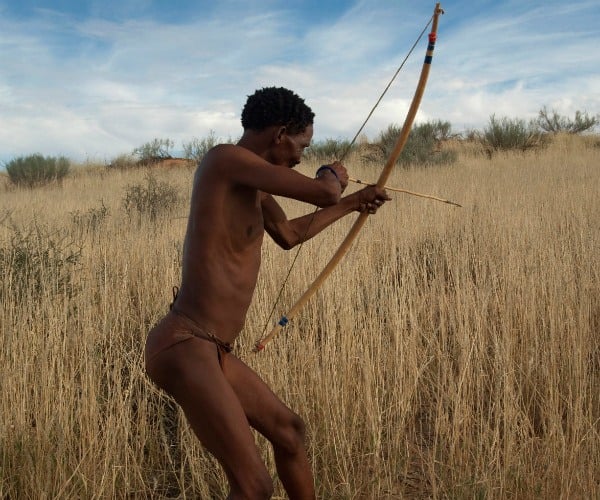 They would follow the desert xox as he sniffed for desert truffles, scaring him away to take the prize. To us the tribe’s lifestyle may seem basic but they enjoyed their luxuries.
A different sense of time
The Khomani San had a different concept of time that contrasts with our time-poor contemporary frantic lives. Once an animal had been wounded by their poisoned arrow they would track it for days until it fell, giving thanks for its life before cooking it.
They would follow the desert xox as he sniffed for desert truffles, scaring him away to take the prize. To us the tribe’s lifestyle may seem basic but they enjoyed their luxuries.
A different sense of time
The Khomani San had a different concept of time that contrasts with our time-poor contemporary frantic lives. Once an animal had been wounded by their poisoned arrow they would track it for days until it fell, giving thanks for its life before cooking it.
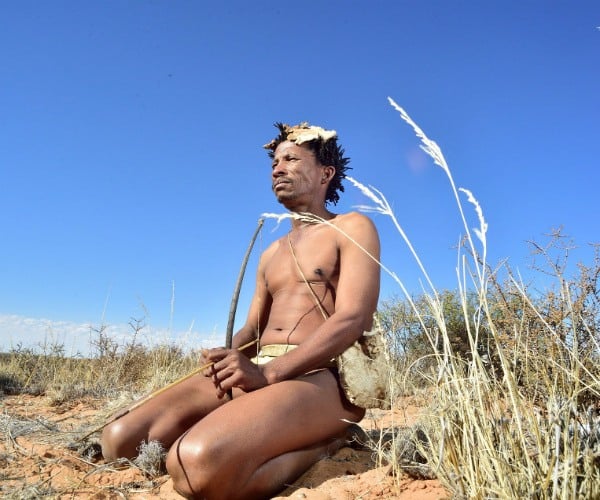 They would chew on hoodia leaves to depress their hunger, they could not stop to eat whilst tracking. Seeing a bee they would follow it hoping to find its hive. If they lost it they would return to that spot until they picked up the trail again. Patience personified.
Arts and culture
As a sophisticated people the Khomani San had time for culture: they danced and they created jewellery. Watch men and women burn intricate designs into fragments of ostrich egg to create necklaces and bracelets at the Xaus Craft Village.
They would chew on hoodia leaves to depress their hunger, they could not stop to eat whilst tracking. Seeing a bee they would follow it hoping to find its hive. If they lost it they would return to that spot until they picked up the trail again. Patience personified.
Arts and culture
As a sophisticated people the Khomani San had time for culture: they danced and they created jewellery. Watch men and women burn intricate designs into fragments of ostrich egg to create necklaces and bracelets at the Xaus Craft Village.
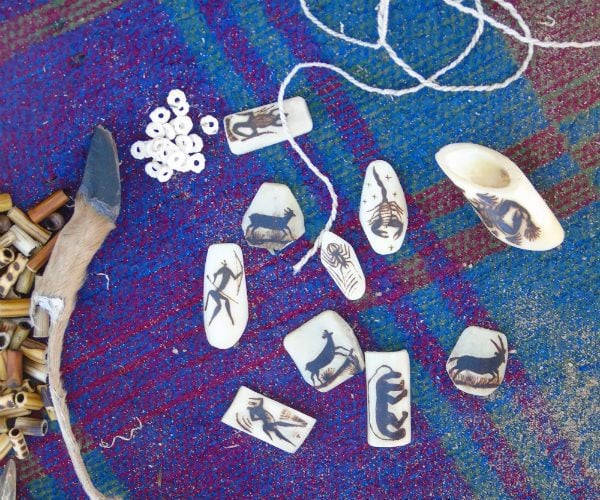 Spend a night with the Khomani San and you will see the traditional shuffling trance-dance of the men as they circle the fire. Take that walk with a bushman and you will be helping to preserve the rich heritage of the Khomani San.
Spend a night with the Khomani San and you will see the traditional shuffling trance-dance of the men as they circle the fire. Take that walk with a bushman and you will be helping to preserve the rich heritage of the Khomani San.
Did you enjoy this article?
Receive similar content direct to your inbox.



My first thought was “This isn’t luxury travel.” Then it dawned on that this is one of the ultimate luxuries.
To step out of time, to see how a people lived for twenty millennia is perhaps one of the greatest luxuries.
As the post says it is a privilege. It has only been over the last 80 years or so that the plane had given us the chance to see such distant places.
At first I was going to write a caustic comment about the travellers being wrapped up in coats and jumpers in the middle of the baking Kalahari.
Then I read the bit about the temperatures dropping to – 10 C at night. Next I worked out that they are on an early morning safari walk to spot the wildlife whilst it’s around and before the sun heats things up. Probably in winter too.
Who needs Sherlock Holmes??
The jewellery is incredible. Such delicate skills. If you could get that into some craft shops in the cities it would sell loads. It is different. They must have so much patience to make these pieces.
The picture of the bare feet on the cracked desert is brilliant, it says so much. It really makes you think that a true water shortage is more than not being able to water the plants on your patio.
I know that it is an over used cliche but this really looks like a life-changing experience. I would be very interested in doing this authentic Bushman’s Safari, the real deal. Where do you stay? These pictures look to be miles from anywhere.
I stayed at Molopolo a comfortable but not luxurious Lodge as a base for my first walk with a bushman.
Then I entered the Kgalagadi Transfrontier Park to stay at Xaus Safari Lodge. There I had a walk with a modern member of the Meir tribe though he had infinite local knowledge and visited the Xaus Craft Village. Xaus lodge is far more luxurious and you can watch wildlife gather at the salt pan.
The Khomani San tribe simply shows us that life is precious and it can be enjoyed in the simplest ways we can never think of since technology has taken over majority of the world now. People nowadays cannot even live without a cellular phone. If I visit them, for sure I’ll feel how good it is to go back to the basics.
I see great importance in looking back to history because it show us how far we have come and how big the changes in our society and lives are. I think there are more reasons why we should experience to walk with people coming from indigenous groups. It is more than being knowlegeable about their history or culture but also sharing thoughts about the modern society. It is very important for us to understand how they adapt to the fast changing world and how they perceive it to be better or worst than before. I hope more people would be interested in learning about culture with others who belong in these kinds of tribe or ethnicity.